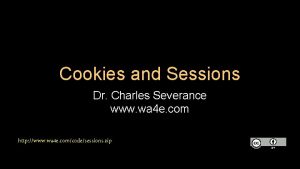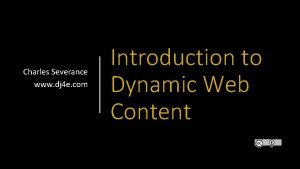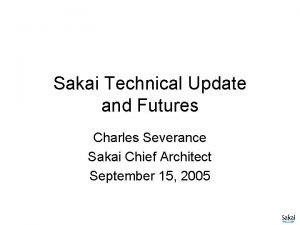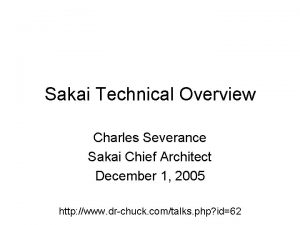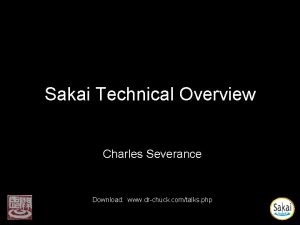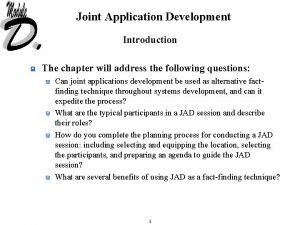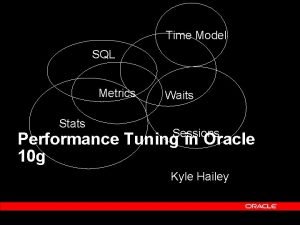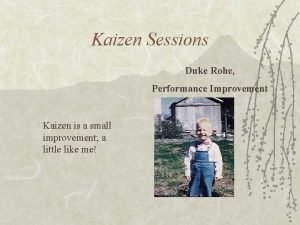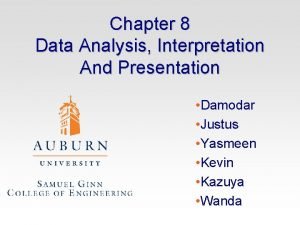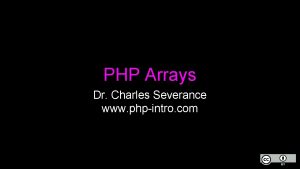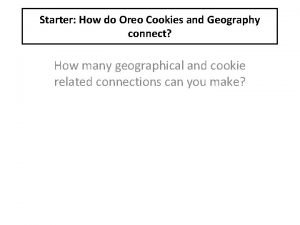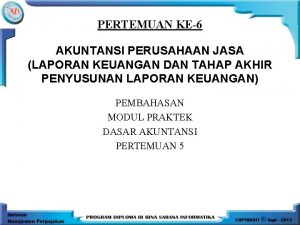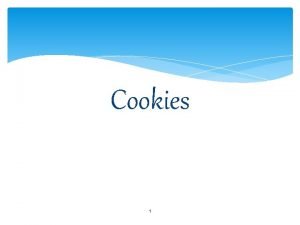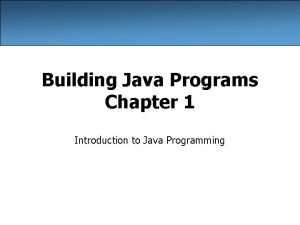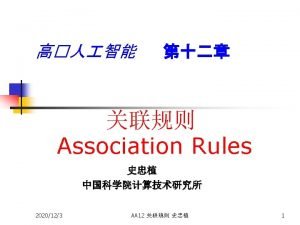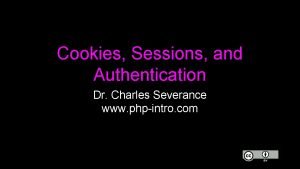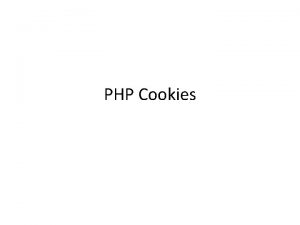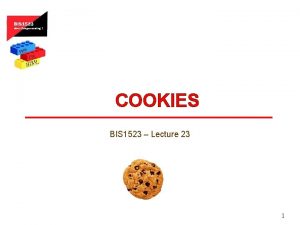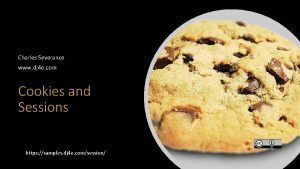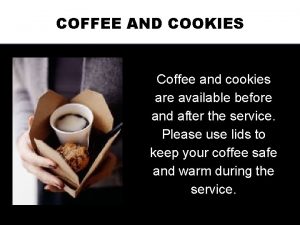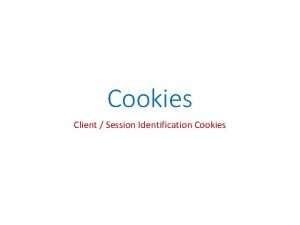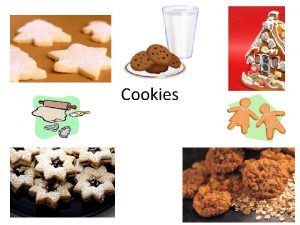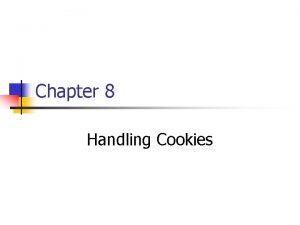Cookies and Sessions Charles Severance www drchuck com

























































- Slides: 57


Cookies and Sessions Charles Severance www. dr-chuck. com

Python HTML BROWSER HTTP Hyper Text Transfer Protocol PHP CSS How stuff looks SERVER How stuff gets back and forth. . . SQL How stuff gets made and stored For each of these aspects of the web, we have many standards and languages and techniques to learn.

www. umich. edu www. facebook. com 29 times The read-only web: hypertext navigation and lots of GETs www. yahoo. com images. yahoo. com (Screenshot) Source: www. facebook. com (Globe) source: http: //www. clker. com/clipart-2123. html (Server) source: http: //www. clker. com/clipart-server. html

ctools. umich. edu Servers get used by many users at the same time. (Screenshots) Source: ctools. umich. edu (Globe) source: http: //www. clker. com/clipart-2123. html (Server) source: http: //www. clker. com/clipart-server. html

When folks hit a button. . . everyone POSTs ? ? ? ctools. umich. edu (Screenshots) Source: ctools. umich. edu (Globe) source: http: //www. clker. com/clipart-2123. html (Server) source: http: //www. clker. com/clipart-server. html

? ? ? Server Questions ? ? ? • • • Who is this user? Are they logged in yet? What screen did they come from? What button did they push? Where do we store this data? What screen do they want next?

? ? ? Server Questions ? ? ? • • • Who is this user? Are they logged in yet? What screen did they come from? What button did they push? Over and over and over. . Where do we store this data? What screen do they want next? same as it ever was

Cookies and Sessions Maintaining State in HTTP

High Level Summary • • The web is “stateless” - the browser does not maintain a connection to the server while you are looking at a page. You may never come back to the same server - or it may be a long time - or it may be one second later So we need a way for servers to know “which browser is this? ” • • In the browser state is stored in “Cookies” In the server state is stored in “Sessions”

Source: https: //weblogin. umich. edu/ Some Web sites always seem to want to know who you are!

Sources: www. twitter. com & www. flickr. com Other Web sites always seem to know who you are!

Source: http: //www. youtube. com/watch? v=f 90 ys. F 9 Ben. I Browser Click Draw You watch the You. Tube video for 30 seconds Whole Page GET Server GET How you see You. Tube. . .

Browser Click Draw Click Whole Page GET Server Draw GET How You. Tube sees you. . .

Multi-User • • When a server is interacting with many different browsers at the same time, the server needs to know *which* browser a particular request came from Request / Response initially was stateless - all browsers looked identical - this was really bad and did not last very long at all.

Web Cookies to the Rescue Technically, cookies are arbitrary pieces of data chosen by the Web server and sent to the browser. The browser returns them unchanged to the server, introducing a state (memory of previous events) into otherwise stateless HTTP transactions. Without cookies, each retrieval of a Web page or component of a Web page is an isolated event, mostly unrelated to all other views of the pages of the same site. http: //en. wikipedia. org/wiki/HTTP_cookie

http: //en. wikipedia. org/wiki/HTTP_cookie

Cookies In the Browser • • Cookies are marked as to the web addresses they come from the browser only sends back cookies that were originally set by the same web server Cookies have an expiration date - some last for years - others are short-term and go away as soon as the browser is closed

Playing with Cookies • • Firefox Developer Plugin has a set of cookie features Other browsers have a way to view or change cookies

(Screenshots) Source: ctools. umich. edu

Two Kinds of Cookies • Two kinds of cookies • • Long-lived - who you are - account name last access time - you can close and reopen your browser and it is still there Temporary - used to identify your session - it goes away when you close the browser

The Firefox Web Developer Plugin Shows Cookies for the Current Host.

Google Analytics Cookies

Request Response Again! This time with cookies. . .

(Screenshot) Source: www. dr-chuck. com HTTP Request / Response Cycle (Review) Web Server HTTP Request HTTP Response Browser Internet Explorer, Fire. Fox, Safari, etc. http: //www. oreilly. com/openbook/cgi/ch 04_02. html

HTTP Request / Response Cycle Web Server GET /index. html HTTP/1. 1 Accept: www/source Accept: text/html User-Agent: Lynx/2. 4 Browser HTTP Request We do or initial GET to a server. The server checks to see if we have a cookie with a particular name set. Since this our first interaction, we do not have cookies set for this host. http: //www. oreilly. com/openbook/cgi/ch 04_02. html

HTTP Request / Response Cycle Along with the rest of the response, the server sets a cookie with some name (sessid) and sends it back along with the rest of the response. Web Server Browser HTTP/1. 1 200 OK Content-type: text/html Set-Cookie: sessid=123 <head>. . </head> <body> <h 1>Welcome. . host: sessid=123 http: //www. oreilly. com/openbook/cgi/ch 04_02. html HTTP Response

HTTP Request / Response Cycle Web Server GET /index. html HTTP/1. 1 Accept: www/source Accept: text/html Cookie: sessid=123 User-Agent: Lynx/2. 4 HTTP Request Browser From that point forward, each time we send a GET or POST to the server, we include any cookies which were set by that host: sessid=123 http: //www. oreilly. com/openbook/cgi/ch 04_02. html

HTTP Request / Response Cycle Web Server On each response, the server can change a cookie value or add another cookie. Browser HTTP/1. 1 200 OK Content-type: text/html Set-Cookie: name=chuck <head>. . </head> <body> <h 1>Welcome. . host: sessid=123 host: name=chuck http: //www. oreilly. com/openbook/cgi/ch 04_02. html HTTP Response

HTTP Request / Response Cycle Web Server GET /index. html HTTP/1. 1 Accept: www/source Accept: text/html Cookie: sessid=123, name=chuck User-Agent: Lynx/2. 4 Browser HTTP Request From that point forward, each time we send a GET or POST to the server, we include all the cookies which were set by that host: sessid=123 host: name=chuck http: //www. oreilly. com/openbook/cgi/ch 04_02. html

Browser Server GET Page Cookies C ookies Page POST Remember that cookies are only sent back to the host that set the cookie.

Security • • • We ony send cookies back to the host that originally set the cookie The browser has *lots* of cookies for lots of hosts To ses all Cookies: Firefox -> Preferences -> Privacy -> Show Cookies

Using Cookies to Support Sessions and Login / Logout

Source: https: //weblogin. umich. edu/ Some Web sites always seem to want to know who you are!

In The Server - Sessions • • • In most server applications, as soon as we meet a new browser we create a session We set a session cookie to be stored in the browser which indicates the session id in use The creation and destruction of sessions is generally handled by a web framework or some utility code that we just use to manage the sessions

Session Identifier • • • A large, random number that we place in a browser cookie the first time we encounter a browser. This number is used to pick from the many sessions that the server has active at any one time. Server software stores data in the session which it wants to have from one request to another from the same browser. • Shopping cart or login information is stored in the session in the server

Server Browser C

Server Request Browser C

Server Session 97 Create Session Request index: Browser C cook=97 7 9 = k o o c Response “Please log in”

Source: https: //weblogin. umich. edu/ Server Session 97 Typing Browser C cook=97 We now have a session established but are not yet logged in.

Login / Logout • • • Having a session is not the same as being logged in. Generally you have a session the instant you connect to a web site The Session ID cookie is set when the first page is delivered Login puts user information in the session (stored in the server) Logout removes user information from the session

Server Session 97 Request 97 = k o co Browser C Click cook=97 login: if good: set user

Server Session 97 user=phil Request 97 = k o co Browser C Click login: if good: set user cook=97 Response

Server Session 97 user=phil Browser C cook=97

Using Sessions for Other Stuff

Server Browser A cook=10 Browser B cook=46 Session 10 Session 46 user=chuck bal=$1000 user=jan bal=$400

Server Browser A cook=10 Session 46 user=chuck bal=$1000 user=jan bal=$500 Browser B cook=46 withdraw: bal=bal-100

Server Browser A cook=10 Session 46 user=chuck bal=$1000 user=jan bal=$500 Browser B cook=46 Click withdraw: bal=bal-100

Server Browser A cook=10 Browser B Session 10 Session 46 user=chuck bal=$1000 user=jan bal=$500 cook=46 withdraw: bal=bal-100

Server Browser A cook=10 Request Browser B Session 10 Session 46 user=chuck bal=$1000 user=jan bal=$400 cook=46 withdraw: Response bal=bal-100

Review. . .

High Level Summary • • The web is “stateless” - the browser does not maintain a connection to the server while you are looking at a page. You may never come back to the same server - or it may be a long time - or it may be one second later So we need a way for servers to know “which browser is this? ” • • In the browser state is stored in “Cookies” In the server state is stored in “Sessions”

Source: http: //www. youtube. com/watch? v=f 90 ys. F 9 Ben. I Browser Click Draw You watch the You. Tube video for an 30 seconds Whole Page GET Server GET How you see You. Tube. . .

Browser Click Draw Click Whole Page GET Server Draw GET

Browser Click Draw GET Server Session 42 cook=42 Whole Page Click Draw Whole Page GET Session 42

? ? ? Server Questions ? ? ? • • • Who is this user? Are they logged in yet? What screen did they come from? What button did they push? Where do we store this data? What screen do they want next?

Cookie/Session Summary • • Cookies take the stateless web and allow servers to store small “breadcrumbs” in each browser. Session IDs are large random numbers stored in a cookie and used to maintain a session on the server for each of the browsers connecting to the server Server software stores sessions *somewhere* - each time a request comes back in, the right session is retrieved based on the cookie Server uses the session as a scratch space for little things
 Dr. charles severance
Dr. charles severance Dậy thổi cơm mua thịt cá
Dậy thổi cơm mua thịt cá Cơm
Cơm Dr charles severance
Dr charles severance Charles severance sakai
Charles severance sakai Charles severance sakai
Charles severance sakai Severance oload.net
Severance oload.net Charles luther manson
Charles luther manson How to conduct a jad session
How to conduct a jad session Uiuc ece 313
Uiuc ece 313 Listening session template
Listening session template Tamu asc
Tamu asc Asn scientific sessions
Asn scientific sessions Webex meetings breakout rooms
Webex meetings breakout rooms The rolling stones origin
The rolling stones origin V$system_wait_class
V$system_wait_class Kaizen sessions
Kaizen sessions Data analysis, interpretation and presentation
Data analysis, interpretation and presentation Severance children's hospital
Severance children's hospital Texas railroad commission completions query
Texas railroad commission completions query Severance intro
Severance intro Severance
Severance Company relational database schema
Company relational database schema Severance streaming
Severance streaming Severance téléchargement direct
Severance téléchargement direct Severance intro
Severance intro Severance network
Severance network Mark severance
Mark severance Convergent boundary oreo
Convergent boundary oreo Cookies frames and frame busting
Cookies frames and frame busting What are the 6 types of cookies with examples?
What are the 6 types of cookies with examples? Browser security model
Browser security model Oreo tectonic plates
Oreo tectonic plates Stoichiometry cookie lab
Stoichiometry cookie lab Please dont eat my cookie
Please dont eat my cookie Syn cookies
Syn cookies Do refrigerator cookies contain a high proportion of fat
Do refrigerator cookies contain a high proportion of fat Same origin policy cookies
Same origin policy cookies Is baking cookies a physical or chemical change
Is baking cookies a physical or chemical change Dxn biscuit
Dxn biscuit Texture of cookies
Texture of cookies Objective of cookies
Objective of cookies Methods of cookies
Methods of cookies Abcsmartcookies
Abcsmartcookies Let's make some cookies
Let's make some cookies Tahap akhir penyusunan laporan keuangan mikita cookies
Tahap akhir penyusunan laporan keuangan mikita cookies V
V Two regions of the mantle
Two regions of the mantle Cookies alert javascript
Cookies alert javascript Cite at least 2 examples of shortened and unshortened cakes
Cite at least 2 examples of shortened and unshortened cakes Un browser
Un browser Cookie manipulation
Cookie manipulation Think twice code once meaning
Think twice code once meaning Assignmentpoint
Assignmentpoint Rolled cookies definition
Rolled cookies definition Algorithm for baking cookies
Algorithm for baking cookies Boston girl bakes chocolate chip cookies
Boston girl bakes chocolate chip cookies Salsa cookies
Salsa cookies
